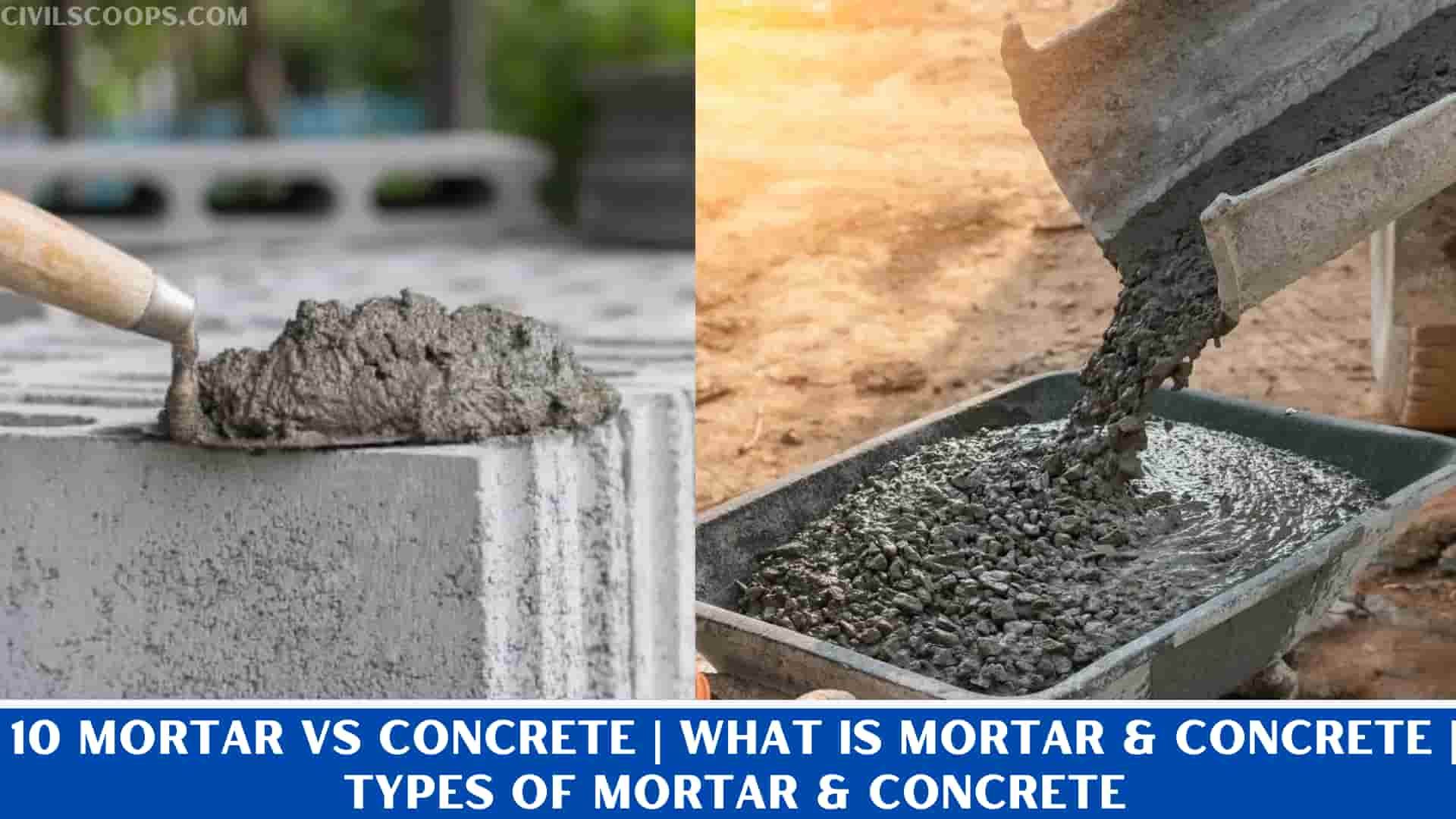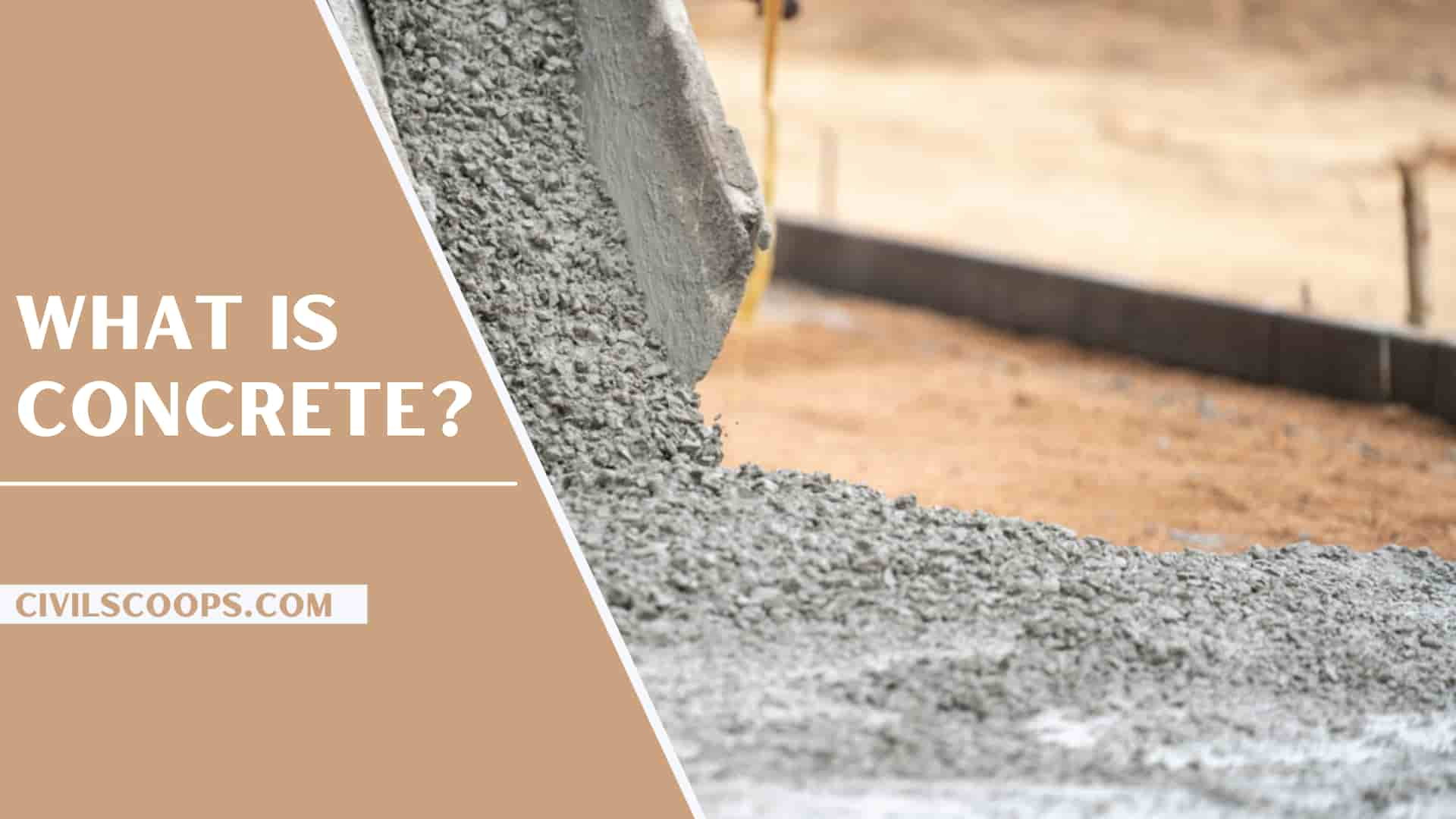10 Different Between Mortar And Concrete | What Is Mortar & Concrete | Types of Mortar & Concrete

Table of Contents
What Is Mortar?
Mortar is a mixture in varying proportions of binding material like cement or lime and an inert material like sand or surkhi (crushed burnt brick) or crushed stone mixed with water.
According to requirement, definite quantities of cementing material, sand, or surkhi, and water is added and thoroughly mixed to make a paste for binding brick or stone masonry and for providing a protective and finishing covering on the inner and outer faces of construction as plaster.
Mortar serves various functions in civil engineering structures. It provides cohesion between bricks or stones and, when hardened, holds the materials together to make those into a single mass of considerable strength.
Mortar forms an even bed between two courses of masonry works, which helps to transfer the loads from the upper to lower layers. It provides resistance against weathering action, particularly against rain. It further acts as a medium for uniformly distributing the forces throughout the structure.
A good mortar should be easily workable, i.e., neither too stiff nor too lean or plastic, and should be capable of retaining sufficient water. It should be capable of offering sufficient resistance to water penetration and should be durable. The mortar should set and harden quickly for faster construction. Further, it should not develop any cracks on drying.
The mortar should not react chemically to the materials being used for jointing. Choice of mortar and its proportion for binding masonry is governed by
Types of Mortar
Mortar is made by using one or more of the following cementing materials depending on the nature of the job, Climatic condition, etc.
- Cement Mortar.
- Lime Mortar.
- Surkhi Mortar.
- Gauged mortar.
- Gypsum Mortar.
What Is Concrete?

Concrete is one of the most important man-made building material used in all major construction projects. Nowadays, concrete plays an important role in the development of infrastructure in numerous ways.
Concrete has three basic ingredients that are aggregate, cement, and water. The role of each ingredient in concrete is different, cement binds the ingredients together, and water gives the concrete viscosity due to which it can be molded in the required shape.
The reaction between the three ingredients gives high strength to the concrete. Concrete is popular because, except cement, all other ingredients of concrete are easily available like different admixtures, aggregate, and water.
Concretes popularity has resulted in several developments and innovations. In the beginning, engineers were struggling to develop a normal concrete, but today they can produce concrete with new characteristics like lightweight, high-performance concrete, ready mixed concrete and self-compacting concrete, etc.
Earlier, only Ordinary Portland Cement (OPC) was used in forming the concrete, but nowadays, concrete is formed using different pozzolanic material, like fly ash, silica fume, volcanic ash and slag along with cement in concrete.
Moreover, nowadays, along with conventional ingredients of concrete-like cement, aggregate, and water, different important admixtures are also used to give concrete required strength and durability essential for a particular application.
Large progress in the development of the concrete possible because of the unprecedented acceptance of concrete as an ideal building construction material. A good concrete show both high compressive strength and durability. Durability is a types of long term guarantee of the serviceability of the concrete in masonry structure without degradation in compressive strength.
Building and structure, service life depends upon the durability which is directly or indirectly controlled by factors like, water-cement (w/c) ratio, compaction and curing time, etc. For increasing the durability of concrete, the use of blended cement in place of normal OPC has been started.
This blended cement is formed by mixing different admixtures like slag, metakaolin fly-ash and silica fumes to the OPC. It increases both the compressive strength and durability of the concrete.
Types of Concrete.
Concrete is formed using a mixed design of the desired workability and durability. In concrete formation, several factors are taken into account as the cost of different additives, aggregates, and types of cement, etc. Broadly concrete can be dived into three important types that are:
- Lime Concrete.
- Cement Concrete.
- Polymer Concrete.
Also Read: All About Polymer Concrete | Why Is Polymer Concrete | Types of Polymer Concrete
Difference Between Mortar and Concrete
[su_table responsive=”yes” ]
| Sr.No. | Mortar | Concrete |
| 1 | Mortar, which is a mixture of water, cement, and sand, has a higher water-to-cement ratio than concrete. | Concrete is a mixture of water, cement, sand just like mortar. However concrete also has gravel and other coarse aggregates that makes it stronger and more durable. |
| 2 | Mortar is made from cement, sand, and water. | Concrete is a mixture of cement, sand, aggregates and water |
| 3 | Mortar is less durable than concrete. | Due to its composing elements it is much stronger as compared to the former. |
| 4 | Has to be replaced every 25-50 years hence not practical for use. | Works intact for a really long time and hence finds application in several purposes. |
| 5 | A less strong, thick mixture, less durable as the latter. | Thinner, stronger more durable as compared to the former. |
| 6 | Best used as a bonding element, for example, glue together bricks or such. | Best used for support such as beams walls and other building foundations i.e. structural purposes. |
| 7 | The water to cement ratio is higher in a mortar and hence acts as perfect glue to bonding materials like brick. | Low water to cement ratio making it an unfit bonding material. |
| 8 | Mortar finds application as a bonding element. | Concrete finds application in structural and decorative purposes like beams, fireplaces, walls etc. |
| 9 | Used as the glue to hold bricks, blocks, etc. toghether | Used for building: Foundation, Slabs, Patios, & Masonry |
| 10 | Various types available for specific applications | Most Flexible forming into any mold & rock hard |
[/su_table]
[su_box title=”FAQ” style=”default” box_color=”#333333″ title_color=”#FFFFFF” radius=”3″ class=”” id=””]
Difference Between Mortar and Concrete
Basically concrete is stronger and more durable so it can be used for structural projects such as setting posts whereas mortar is used as a bonding agent for bricks, stones, etc. Concrete is a mixture of water, cement, sand just like mortar.
Concrete Mortar
Mortar is composed of cement, fine sands, and lime; it is used as a binding material when building with brick, block, and stone. Concrete is a very strong structural building material composed of cement, sand, and larger aggregate (gravel).
Cement Mortar
Mortar is yet another building material composed of cement, which in this case is mixed with fine sands and water, with lime added to improve the durability of the product. Adding water to this mix activates the cement so that it hardens, or cures, just as with concrete.
Concrete Repair Mortar
Repair mortars are specifically designed for restoring or replacing the original profile and function of the damaged concrete. They help to repair concrete defects, improve appearance, restore structural integrity, increase durability and extend the structure’s longevity.
Portland Cement Mix
A standard ratio for mixing concrete from raw materials is 1 part Portland, to 2 parts concrete sand, to 3 parts gravel by VOLUME. For example, one 92.6 lb bag of QUIKRETE® Portland cement, 167 pounds of concrete sand, and 295 pounds of gravel will yield approximately 4.1 cubic feet of concrete.
Can I Use Concrete Instead of Mortar?
Though both mortar and concrete are widely used building materials, they cannot be substituted for each other without compromising the integrity of a build.
Difference Between Mortar and Grout
Mortar is the adhesive used to hold tiles to a surface or substrate. Grout, on the other hand, is the substance applied between the tile spaces to fill and seal the gaps. There’s a mortar or grout product for every type of tile and tile location.
Difference Between Cement and Concrete
Although the terms cement and concrete often are used interchangeably, cement is actually an ingredient of concrete. Concrete is a mixture of aggregates and paste. The aggregates are sand and gravel or crushed stone; the paste is water and portland cement.
Masonry Cement Vs Mortar Cement
ASTM C91 defines masonry cement by physical requirements and performance properties rather than ingredients. Mortar cement, a relatively new designation, was developed for demanding structural applications and features higher strength and lower air content than masonry cement.
What Is Mortar Made Of?
Conventional mortar is a mixture of cement, lime, and sand, with the proportion of cementitious materials to sand typically near 1:3. In some localities, a proprietary product called “masonry cement” is used to replace the Portland cement and lime in the traditional mix.
[/su_box]
[su_note note_color=”#F2F2F2 ” text_color=”#333333″ radius=”3″ class=”” id=””]
Like this post? Share it with your friends!
Suggested Read-
- All About Rat Trap Bond | What Is Rat Trap Bond | How to Use | Advantage & Disadvantage of Rat Trap Bond
- All About Fish Ladder | What Is Fish Ladder | Types of Fish Ladder | Fish Ladders in Dams
- All About Polymer Concrete | Why Is Polymer Concrete | Types of Polymer Concrete
- All About Pier and Pile | Difference Between Pier and Pile | What Is Pier | What Is Pile
- All About Flooring | What Is Flooring | 11Types of Flooring.
[/su_note]
Originally posted 2022-07-31 21:19:14.
